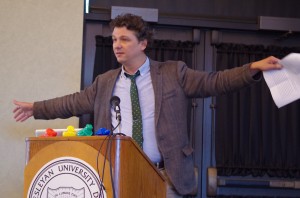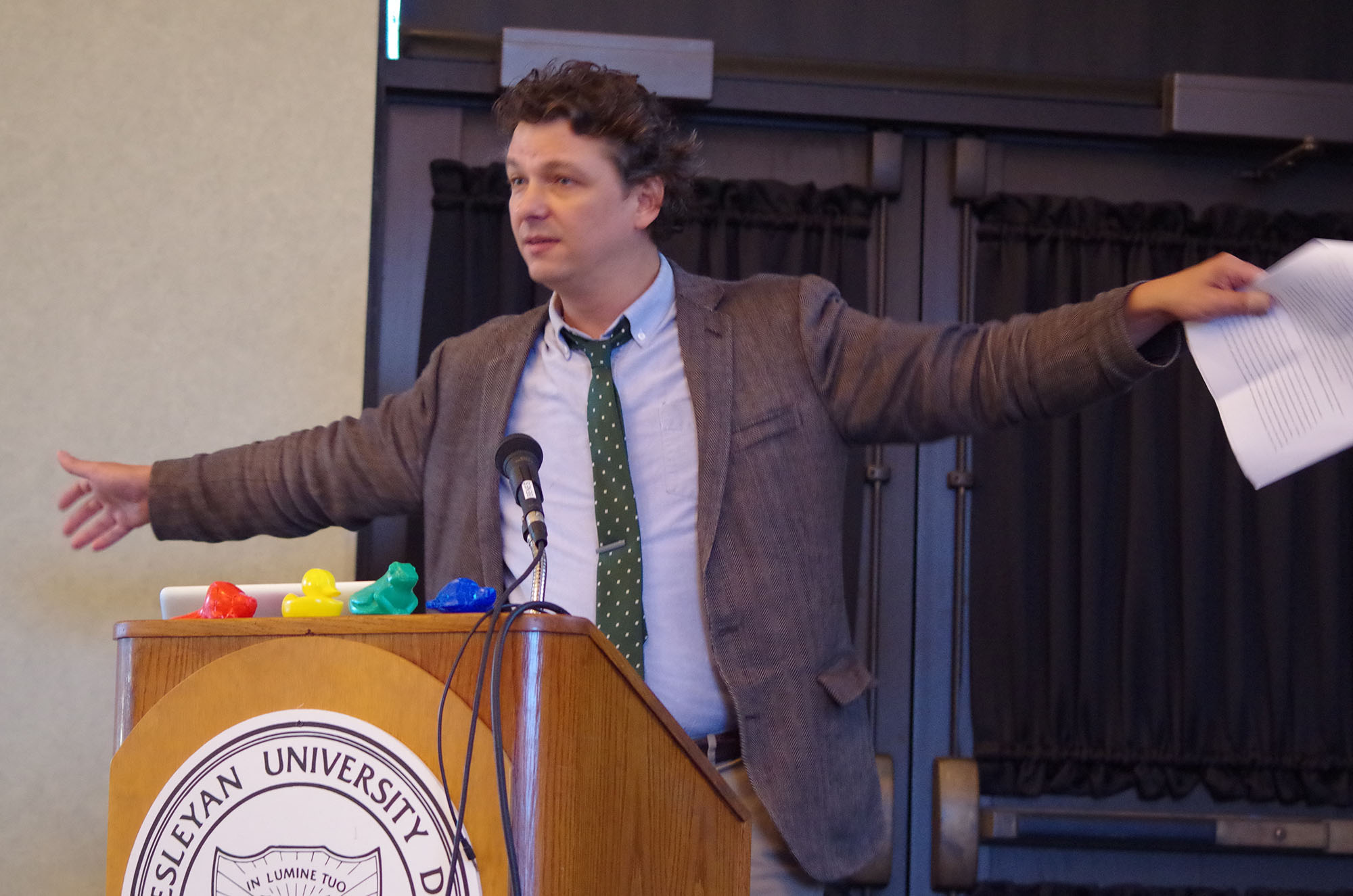
By Miranda Anthony
Transcript Reporter
Thursday at 7 p.m., national bestselling author Donovan Hohn presented “The Blind Oceanographer: Lessons from the Hunt for Moby Duck” to students and faculty members in the Hamilton-Williams Campus Center, launching Ohio Wesleyan University’s 2014 Sagan National Colloquium series.
Founded in 1984 by university President David Warren, this year marks the 30th anniversary of the series, which aims to weld liberal arts learning with community involvement by actively engaging students in issues of national and international concern. Ellen Arnold, Ph.D., assistant professor of history, has chosen this year’s colloquium theme of H2OWU: Water in Our World, in which students will explore water from various perspectives and disciplines.
“It promises to be an exciting and engaging semester,” Arnold said.
“(And) a clear reminder of the values and virtues of the kind of broad, interdisciplinary, and engaged educational experience that Ohio Wesleyan prides itself in.”
Hohn’s presentation focused on the recurring theme of “the limitations of the human eyeball as an instrument of revelation” within his non-fiction, national bestseller “Moby-Duck: The True Story of 28,800 Bath Toys Lost at Sea and of the Beachcombers, Oceanographers, Environmentalists, and Fools, Including the Author, Who Went in Search of Them.”
In his book, Hohn said, “It wasn’t that I wanted, like Cook and Amundsen and Vancouver and Bering and all those other dead explorers, to turn terra incognita into terra cognita, the world into a map.
“Quite the opposite. I wanted to turn a map into a world.”In a region known as the Graveyard of the Pacific, on Jan. 10, 1992, an entire shipment of 28,800 bathtub toys—including 7,200 rubber ducks—was released into the ocean as a result of tempestuous weather conditions; and, overtime, the toys drifted in many directions, washing onto shorelines all over the world.
Hohn, who was an English teacher at the time, first learned about this occurrence from a student’s paper. Contacting Curtis Ebbesmeyer, who published the story in The Beachcomber Alert!, Hohn soon found himself embarking on a journey, where he, alongside oceanographers and environmentalists, would retrace paths of the lost bath toys, tour the Chinese factory in which they were made, and search for those that had yet to be found.
“The challenge that I set for myself and what I look for,” Hohn said, “is a way to tell a story that avoids simplistic debunking or simplistic sensationalism.”
Claiming that much of what we see is through the lens of another’s camera, Hohn explains the biases often found in photographs of nature, and, more generally speaking, in environmental journalism.
“It is the norm,” Hohn said, “that seeing is synonymous with knowing, but photographs can be deceiving. Our eyes aren’t enough. We need to read the natural world as well as see it.”
Hohn’s assessment of photography particularly sparked the interest of sophomore Cindy Hastings, who, following the lecture, was one of many students and faculty members waiting in line to speak with Hohn.
“It’s really interesting how photographs often separate the truth from the context surrounding them,” Hastings said, “and then separates the portrayed reality from the actual reality.”
In a later interview, Hohn credits American writer Annie Dillard for inspiring him to explore the relationship between sight and knowledge and its complexities through her essay Seeing, which begins with an anecdote: Dillard recounts hiding pennies—as a small child—for strangers, evolving into a metaphor for the act of “seeing.”
“There lots of things to see,” Dillard wrote, “unwrapped gifts and free surprises, if only we care to find them.”
